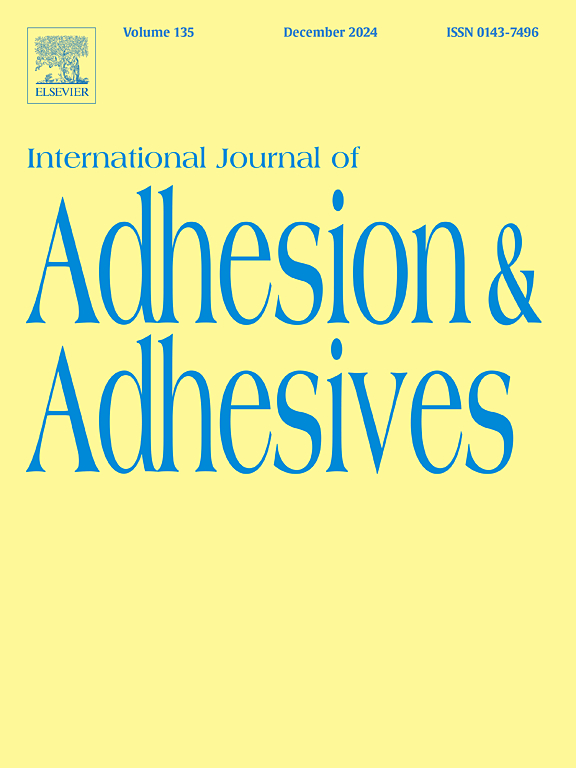Effect of preparation burs on the adhesion of resin-based composite and glass-ionomer to enamel, superficial and deep dentin - Diamond, carbide or Arkansas bur?
IF 3.5
3区 材料科学
Q2 ENGINEERING, CHEMICAL
International Journal of Adhesion and Adhesives
Pub Date : 2025-02-23
DOI:10.1016/j.ijadhadh.2025.103993
引用次数: 0
Abstract
Objective
This study aimed to determine whether the bur type affects the adhesion of resin-based composite and glass-ionomer restorative materials to enamel and dentin at different depths.
Methods
Wisdom molar teeth (N = 216) were prepared using three different types of burs: a) extra-fine diamond-coated bur, b) carbide bur (16–20 blade) and c) Arkansas bur at three occlusal depth levels: enamel, superficial dentin, and deep dentin. Specimens were then randomly assigned to receive either resin composite (RC) or glass-ionomer (GI). Half of the specimens were tested 24 h after bonding (dry) while the other half after thermocycling (500 cycles, 5–55 °C) for shear bond strength in a universal testing machine. Data were analyzed using Kruskal-Wallis, Wilcoxon rank-sum test with Bonferroni adjustment (α = 0.05). Additionally, Weibull modulus for each group was calculated to assess adhesion reliability using the various bur types on different substrates.
Results
The bur, restorative material type and aging affected the bond strength results (p<0.05) and the interaction terms were significant (p<0.05). In dry conditions, bur type did not affect the bond strength results (MPa) significantly on enamel and superficial dentin for both RC (5.73 ± 4.4–11.99 ± 7.62) and GI (4.93 ± 2.8–2.73 ± 0.75) (p>0.05). On deep dentin, carbide bur performed significantly better for RC (10.44 ± 4.08) than other bur types (6.06 ± 2.36–6.56 ± 3.58) (p<0.05). After thermocycling, bur type did not affect the bond strength results (MPa) significantly on enamel for both RC (13.19 ± 4.9–13.06 ± 5.57) and GI (4.50 ± 3.76–4.90 ± 3.11) (p>0.05). While on superficial dentin, bur type did not affect the bond strength results for RC (10.17 ± 5.98–7.07 ± 3.58), for GI diamond bur resulted in significantly lower bond strength (1.65 + 1.01) (p<0.05). On deep dentin, bur type did not affect the results for GI (3.24 ± 2.32–4.48 ± 2.26) but diamond bur resulted in higher bond strength (12.62 ± 6.47) than those of other burs (6.62 ± 3.05–7.14 ± 5.12) (p<0.05). Weibull modulus after thermocycling was the highest for Arkansas in RC (3.23) compared to other bur-material combinations (m = 1.6–2.9). After thermocycling, adhesion to enamel was not affected but independent from bur-material combinations in superficial and deep dentin increased significantly (p<0.05).
Significance
Tooth preparation on enamel does not benefit from the use of different bur types for increased adhesion both with resin composite and glass-ionomer. While a diamond bur cannot be recommended for glass-ionomer on superficial dentin, the same bur type enhances adhesion on deep dentin.
制备毛刺对树脂基复合材料和玻璃离子聚合物与牙釉质、浅、深层牙本质附着力的影响-金刚石、硬质合金或阿肯色毛刺?
目的探讨树脂基复合材料和玻璃离子修复材料在不同深度对牙本质和牙釉质粘附的影响。方法在牙釉质、浅牙本质和深牙本质三个咬合深度水平上,采用超细金刚石磨刀、硬质合金磨刀(16-20刀刃)和阿肯色磨刀三种不同类型的磨刀制备瑞士磨牙(216颗)。然后随机分配标本接受树脂复合材料(RC)或玻璃离子(GI)。一半试件在粘接后24 h(干燥)进行测试,另一半试件在通用试验机上进行热循环(500次,5-55℃)测试剪切粘接强度。数据分析采用Kruskal-Wallis, Wilcoxon秩和检验,Bonferroni校正(α = 0.05)。此外,计算每个组的威布尔模量,以评估使用不同类型的不同基材的粘附可靠性。结果粘结强度结果受修复材料类型、龄期影响(p < 0.05),相互作用项显著(p < 0.05)。干燥条件下,牙槽类型对RC(5.73±4.4 ~ 11.99±7.62)和GI(4.93±2.8 ~ 2.73±0.75)的牙釉质和浅牙本质粘结强度结果(MPa)均无显著影响(p>0.05)。在深部牙本质上,硬质合金钎具的硬度(10.44±4.08)明显优于其他类型钎具(6.06±2.36-6.56±3.58)(p < 0.05)。热循环后,牙体类型对RC(13.19±4.9 ~ 13.06±5.57)和GI(4.50±3.76 ~ 4.90±3.11)牙釉质粘结强度结果(MPa)均无显著影响(p > 0.05)。在表层牙本质上,牙钉类型对RC(10.17±5.98 ~ 7.07±3.58)的牙本质结合强度无影响,而GI钻石牙钉的牙本质结合强度显著降低(1.65 + 1.01)(p<0.05)。在深层牙本质上,牙钉类型对牙床硬度无明显影响(3.24±2.32-4.48±2.26),但金刚石牙钉对牙床黏结强度的影响(12.62±6.47)高于其他牙钉(6.62±3.05-7.14±5.12)(p < 0.05)。与其他燃烧材料组合(m = 1.6-2.9)相比,阿肯色州在RC中热循环后的威布尔模量最高(3.23)。热循环后,表面和深层牙本质与牙釉质的粘结力不受影响,且不受牙釉质-材料组合的影响(p < 0.05)。在牙釉质上制备牙齿时,不同类型的牙釉质与树脂复合材料和玻璃离子聚体的附着力都不相同。虽然金刚石金刚石不能用于表面牙本质上的玻璃离子,但同样类型的金刚石可以增强深层牙本质的附着力。
本文章由计算机程序翻译,如有差异,请以英文原文为准。
求助全文
约1分钟内获得全文
求助全文
来源期刊

International Journal of Adhesion and Adhesives
工程技术-材料科学:综合
CiteScore
6.90
自引率
8.80%
发文量
200
审稿时长
8.3 months
期刊介绍:
The International Journal of Adhesion and Adhesives draws together the many aspects of the science and technology of adhesive materials, from fundamental research and development work to industrial applications. Subject areas covered include: interfacial interactions, surface chemistry, methods of testing, accumulation of test data on physical and mechanical properties, environmental effects, new adhesive materials, sealants, design of bonded joints, and manufacturing technology.
 求助内容:
求助内容: 应助结果提醒方式:
应助结果提醒方式:


